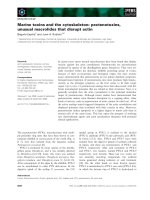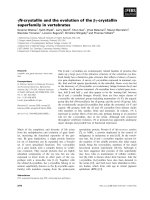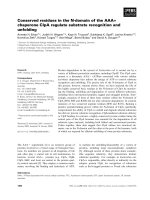Báo cáo khoa học: "Result Stages and the Lexicon : The Proper Treatment of Event Structure" pot
Bạn đang xem bản rút gọn của tài liệu. Xem và tải ngay bản đầy đủ của tài liệu tại đây (303.74 KB, 4 trang )
Proceedings of EACL '99
Result Stages and the Lexicon :
The Proper Treatment of Event Structure
Patrick Caudal
TALANA, UFR de Linguistique, Universit~ Paris 7
2, place Jussieu
75251 Paris Cedex 05, FRANCE
caudal @linguist.jussieu.fr
Abstract
I will argue in this paper that the standard
notions of
affectedness, change-of-state
and
result state
are too coarse-grained, and will
revise and enrich substantially their content,
increasing their role in a compositional aspect
construal procedure. I will claim in particular
that a proper theory of event structure requires
that enriched
result states
should be lexically
represented, and will base on them a
computational treatment of event structure
within a feature-structure-based lexicon.
Introduction
Event structure is traditionally accounted for using
two sets of notions : change-of-state / affectedness
and incrementality. I will examine both in this paper,
determining their respective limitations, before
proposing an alternative approach and the formal
specifications for a computational implementation.
1 From affectedness to result states:
how can we account for event structure .9
1.1 Affectedness, change-of-state and
telicity
Telic events are generally viewed as an opposition
between a previously holding state and a new one,
called a
result state
(e.g.
dead(y)
for
x kills
y). They
trigger a
change-of-state
(COS, henceforth), result
states (RSs, henceforth) being entailments of CoSs.
Moens and Steedman (1988), Smith (1991),
Pustejovsky (1995), and others argue that it is a
defining property of telic events. They should
therefore include an 'undergoer' argument, whose
CoS determines the telicity of the event (i.e., it acts as
a measuring-out
argument). Tenny (1987) thus
claims that telic events require such an argument,
which she calls an
affected
argument. Consider for
instance
John reviewed the paper:
as the event
reaches its culimation, the affected argument
undergoes a CoS (from
,reviewed(paper)
to
reviewed(paper)),
producing a RS. To put it short, the
standard theory of event structure says that telicity
implies affectedness (and conversely), and that
affectedness implies a CoS/RS (and conversely),
associating tightly all those notions.
Unfortunately, not all measuring-out arguments
are
affected arguments :
( 1 ) Two men carried Hirsch on the deck.
Jackendoff (1996:309) observed that (implicit) paths
such as
on the deck
in (1) are not affected arguments,
so that the telicity of such motion events cannot be
explained using affectedness, ruling out a unified
affectedness-based account of telicityL It follows
from this objection that the standard theory should be
at least amended. Jackendoff's solution is a general
mapping function from measuring-out arguments
(seen as paths) to events. It is related to
incrementality,
which I am discussing below.
1.2 Result states and incrementality
Event-object mapping functions, as proposed in
Krifka (1992) and Dowty (1991), are another key
approach to the treatment of event structure. Dowty
(1991) calls an
incremental theme
any argument
I Yet motion verbs could be attributed an affected
argument, i.e., their agents, so thatJackendoff's point
against affectedness does not seem to be decisive.
233
Proceedings of EACL '99
capable of measuring-out an event. For instance, the
drinking event in (2) can be measured along the
quantity of beer contained in the glass through
functions mapping the latter onto the former.
(2)
John drank a glass of beer.
The glass of beer in (2) undergoes an incremental
CoS, and is therefore an incremental theme. Path-
objects (cf.
Mary walked the Appalachian trail ;
Tenny 1994), can be treated as some special kind of
incremental themes, and Jackendoff's solution could
thus be reformulated using incrementality 2.
Let us turn now to the treatment of so-called
achievement
verbs (cf. Vendler 1957). Most authors
do not grant them incremental themes. Dowty (1991),
for instance, argues that incremental themes must be
able to undergo an incremental CoS :
(3a)
??The horse finished crossing the line.
(OK in slow motion)
(3b)
The horses finished crossing the line.
(3a) shows indeed that
cross the line
lacks proper
subevents, and that no incremental CoS occurs. But
Dowty never considered examples such as (3b),
which receive an incremental reading (albeit of a
different kind, since the subevents construed in (3)
involve
individual parts of a set of objects
rather than
non-individual parts of an individual object,
as in
(2)). Therefore, I will conclude that the kind of
affected arguments which
achievement
verbs possess
can also be regarded as incremental themes. It seems
at this point that all kinds of telic events can be
analysed in terms of incrementality. However, I will
show in the following section that this is not the case.
Generally speaking, relying on incrementality alone
would mean relegating CoSs and RSs to the
backstage of aspect construal 3 : in order to account
for telicity without affectedness, one should deny a
central role to CoSs, and regard telicity primarily as a
matter of measure. I will propose an alternative
solution in the following sections preserving the
centrality of CoS, yet departing from the standard
2 See Jackendoff (I 996) for some syntactic provisos.
3 At least in the case of path-movement verbs, cf. (1).
approach to affectedness and CoS, and justified by
data falling outside the scope of incrementality.
2. A richer conception of result states
for a proper treatment of event structure
2.1 RSs with
and without change-of-state
I will argue here that different types of affectedness
and RSs (e.g., entailing a CoS for telic events, and
not entailing a CoS for atelic ones) should be
distinguished, going against the predominant
position. Few authors mention the possibility for
atelic events to receive RSs, or do it incidentally
(e.g., Parsons 1990). But consider the following data :
(4)
Loom Mona has been very sick. t
(5)
Mona has already sailed.
(4) and (5) denote a present state-of-affairs (Mona's
poor looks in (4) / sailing expertise in (5)) following a
past fact - yet no CoS is involved. Let us now turn to
verbs of
gradual
CoS :
(6)
Mona cooked this chicken in/for two hours.
(7)
Mona has only slightly I not too much cooked
her chicken.
(8)
??John has only slightly / not too much drunk
his glass of beer.
(6) can be read as telic or atelic, and although its
internal argument is undergoing a CoS, it is not an
incremental CoS, since the
whole
of the chicken is
gradually affected (and no__!t its subparts ; compare
(2)). It seems rather that the progression of the
cooking event depends on the internal structure of the
associated RS : the event develops as the chicken is
more and more
cooked
(see Ramchand (1997) for a
similar analysis4). The types of RSs and affectedness
involved differ clearly from those of the incremental
telic events considered so far. Such RSs as that of
4 Jackendoff (1996) also proposes RSs as paths for such
events. But the impact on event structure of the difference
between the scalar CoS in (6) and the incremental one in
(2) cannot be motivated in such works, since it is related to
a difference in the associated RSs. The incrementality
approach misses this point, so that RS-based paths are
rather
ad hoc
devices.
234
Proceedings of EACL '99
cook
are
scalar,
i.e., can vary in terms of degrees (see
(7)), so that a 'final' degree may or may not be
reached. Contrariwise, incremental events are not
endowed with scalar RSs / affectedness (cf. (8)) : one
does not drink something 'to a certain degree /
intensity'. It appears now that a proper treatment of
event structure requires a richer conception of RSs,
CoSs and affectedness, and cannot be exclusively
based on incrementality.
.Legend : x°y : x overlaps with y ; x<y : x precedes y ; x<*y
: ordered part-of relationship between events ;
(9)
drink (
e,
x,
y)
drink_IStage (e,,x,y) drink RStage (e2,y)
i
drink_P_RS (e3, y) drink_S_RS (e4, y)
:F, e3
<
e 4
A
e 3 e 1 *Y ex <* e 2
I assume that events canonically break down into at
least two stages: RStages and Inner Stages (noted
IStages), the latter describing an events'
development
- e.g., the drinking process assumed to precede the
end of a drinking event.
Briefly, telic events will receive a
binary
RStage (cf
(10)) consisting of a
primary
RS and a
secondary
RS,
the former being related to the development of the
event (cf.
John has been drinking beer)
and the latter
to its culmination (i.e., to the state of affairs arising
from the event's final completion ; cf.
John has drunk
a beer).
Moreover, the secondary RS should be the
complementary of the primary RS, so as to cause a
definite CoS 5. The diagrams (9) and (10) indicate that
the primary RSs of
drink
and
run
overlap with their
respective IStages, and that the Secondary RS of
drink
abuts with both its primary RS and IStage.
Moreover, the sortal opposition between primary and
secondary RSs should be viewed as a
transition
function.
I assume here that transition functions (i.e.,
functions allowing for CoSs) require such binary
sortal domains, in the spirit of Pustejovsky
(lbrthcoming). Some kind of causal relationship is
5 Path-object verbs as in (1) can also be analysed in terms
of RStages. I will not discuss here the treatment of this and
many other event types for want of space.
2.2 RStages
as sets of sorted
RSs
To formulate an alternative treatment of event
structure accounting for the data presented above, I
will introduce
result stages
(RStages henceforth),
consisting of one or several RSs. I am moreover
assuming here that semantic features and categories
are treated within a multi-sortal logic, possessing a
hierarchy of sorts organized as an inheritance-based
lattice structure (see White 1994).
: x left overlaps with y
: overlap relationship between events
(lO)
ru:(e,x)
I
run ZStage
(e x,
x)
I
I
run RSt:age (e 2, x)
:F, el * e 2
also assumed to hold between IStages and RStages in
the case of telic events.
Telic scalar verbs like
cook
will receive binary
RStages with
scalar primary RSs. Scalar RSs
will be
defined through
scalar sortal domains,
so as to
account for the behaviour of those verbs. I will not
study here their atelic readings for want of space to
do so. Finally, since atelic events do not entail a CoS,
I will assign them
unary RStages,
devoid of primary
RSs, so that no opposition between two RSs (and
therefore no CoS) arises - see (10).
3. Encoding RStages in the lexicon
I will now propose the formal specifications for a
lexical computational implementation of the above
treatment. Each verb will be assigned a sorted
RStage, sorts being used as well-formedness
conditions. I am proposing in figure 1 a lexical entry
for
drink
within the
Generative Lexicon
framework
(cf. Pustejovsky (1995)). It can be adapted to any
type of feature-structure-based computational
lexicon, though. Note that the m-inc and i-inc
functions are homomorphi¢ aspectual roles relating
events to the individual vs. material subparts of
objects (see Caudal (1999) for further details).
235
Proceedings of EACL '99
Figure 1. Lexical representation of
drink
within the
Generative Lexicon
framework
"-Drink
ARGSTR =
EVENTSTR
=
QUALIA
=
ARGI =
ARG2
=
RESTR =
I-Stage =
R-Stage =
I FORMAL =
ONSTITUTIVE =
GENTIVE
=
x : animate_ind ^ i-inc(x,e I)
y : beverage ^ m-inc(y, ea)
<*
e x : ~ drinking_act(el,x,y)
e 2 : ~ Binary m-inc RStage(e2,Y)
~ ^ Delimited(e2) I
z-stage / R-Stage describe the Inner and Result
Stages. The Delimited sort indicates delimited
events, while the Binary_m-inc_RStage sort bears
the transition function (i.e., the binary sortal domain)
attached to
drink,
thus allowing it to be read as an
incremental telic event ; cf. (9).
Conclusion
The treatment proposed here receives indirect support
from recent developments in the syntax-semantics
interface underlining the importance of affectedness
and CoS in argument structure and aspect construal ;
cf. Ramchand (1998). Yet the novelty of this
approach to event structure should be stressed w.r.t.
the standard notions prevailing in the (even recent)
literature, while it does not belittle the role of the
usual apparatus about IStages, telicity and event-
object mapping functions. It rather
pairs
them with
RStages. Finally, the present account offers a more
unified and explanatory treatment of event structure
than those essentially based on incrementality, since
they have to rely on RS-based paths to explain the
telicity of scalar verbs and resultative constructions.
To my knowledge, and although it has not been
exposed here in detail, the RStage-based approach to
event structure can be extended to all event types.
References
Caudal, P. 1999. Computational Lexical Semantics,
Incrementality and the So-Called Punctuality of
Events.
Proceedings of the 37 'h Annual Meeting,
University of Maryland, June. Association for
Computational Linguistics.
Dowty, D. 1991. Thematic Proto-Roles and
Argument Selection.
Languages,
67(3).
Jackendoff, R. 1996. The Proper Treatment of
Measuring Out, Telicity and Perhaps Event
Quantification in English.
Natural Language and
Linguistic Theory,
14.
Krifka, M. 1992. Thematic Relations as Links
between Nominal Reference and Temporal
Constitution. In I. Sag and A. Szabolsci, editors,
Lexical Matters.
CSLI Publications, Stanford, CA.
Moens, M. and M. Steedman. 1988. Temporal
Ontology and Temporal Reference,
Computational
Linguistics,
14(2).
Parsons, T. 1990.
Events in the Semantics of English -
A Study in Subatomic Semantics.
MIT Press,
Cambridge, MA.
Pustejovsky, J. 1995.
The Generative Lexicon.
MIT
Press, Cambridge, MA.
Pustejovsky, J. (forthcoming). Decomposition and
Type Construction. Ms., Brandeis University, MA.
Ramchand, G. 1997.
Aspect and Predication.
Clarendon Press, Oxford.
Ramchand, G. 1998. Deconstructing the lexicon. In
M. Butt and W. Geuder, editors,
The Projection of
Arguments.
CSLI, Stanford, CA.
Smith, C. 1991.
The Parameter of Aspect.
Kluwer,
Dordrecht.
Tenny, C. 1987.
Grammaticalizing Aspect and
Affectedness.
Ph.D. dissertation, Department of
Linguistics, MIT, Cambridge, MA.
Tenny, C. 1994.
Aspectual Roles and the Syntax-
Semantics Interface.
Kluwer, Dordrecht.
Vendler, Z. 1957. Verbs and Time.
The Philosophical
Review,
66.
White, M. 1994.
A Computational Approach to
Aspectual Composition.
Ph.D. dissertation,
Institute for Research in Cognitive Science,
University of Pennsylvania, Philadelphi a .
236









